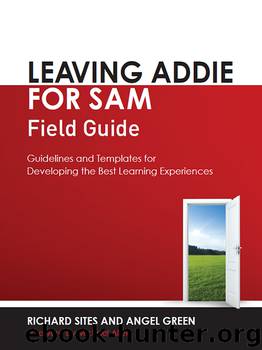Leaving Addie for SAM Field Guide: Guidelines and Templates for Developing the Best Learning Experiences by Richard Sites & Angel Green

Author:Richard Sites & Angel Green [Sites, Richard; Green, Angel]
Language: eng
Format: epub
ISBN: 978-1-60728-409-3
Publisher: ASTD Press
Published: 2014-03-10T16:00:00+00:00
DOCUMENTING THE SAVVY START
In the post-Savvy, iterative design phase, there are many loose ends that need to be tied up. Design continues following the same process as in the Savvy Start, although usually with a select team to speed things along and reduce costs. But, most importantly, there is planning to do (page 127).
During the Savvy Start, the team discusses performance issues, brainstorms design ideas, and evaluates prototypes. Some will need revision, some will be discarded, and some have yet to be built. These decisions and activities should be documented for future reference as the speed of work can make the basis of decisions difficult to recall.
Documentation of a Savvy Start, called the Savvy Start summary report, serves as a reference for future design discussions and project planning. The summary report contains all of the relevant decisions, information, and designs addressed in the Savvy Start. A copy sent to each member of the Savvy Start team for review helps to get everyone’s input and consent. And this is pretty important!
Below are the key components of a Savvy Start summary report:
• Overview (or summary) of the Savvy Start: Recaps the who, what, where, why, and how of the meeting. This should provide enough information for someone who did not attend to have an appreciation for what occurred during the Savvy Start.
• The need for the training: States the initial goals for the learning project and any revisions that came about during the brainstorming discussions.
• Course overview: Provides a good overview of the early design for the project as a whole. This may include expected learning time, how it will be delivered, when, and to whom.
• Objectives x Treatment Matrix: Creates a matrix that aligns the instructional objectives with interactive treatments. This matrix will serve as the basis for additional design and project planning. (See Leaving ADDIE for SAM, pages 111–114.)
• Instructional treatment description (using CCAF): Starting with photos of the sketches or screen captures of each prototype created during the Savvy Start, write out the description of the context, challenge, activity, and feedback for each prototype.
Download
This site does not store any files on its server. We only index and link to content provided by other sites. Please contact the content providers to delete copyright contents if any and email us, we'll remove relevant links or contents immediately.
| Administration | Assessment |
| Educational Psychology | Experimental Methods |
| History | Language Experience Approach |
| Philosophy & Social Aspects | Reform & Policy |
| Research |
The Art of Coaching Workbook by Elena Aguilar(50763)
Trainspotting by Irvine Welsh(21461)
Twilight of the Idols With the Antichrist and Ecce Homo by Friedrich Nietzsche(18457)
Fangirl by Rainbow Rowell(9034)
Periodization Training for Sports by Tudor Bompa(8103)
Change Your Questions, Change Your Life by Marilee Adams(7574)
This Is How You Lose Her by Junot Diaz(6710)
Asking the Right Questions: A Guide to Critical Thinking by M. Neil Browne & Stuart M. Keeley(5583)
Grit by Angela Duckworth(5456)
Red Sparrow by Jason Matthews(5327)
Paper Towns by Green John(5030)
Room 212 by Kate Stewart(4968)
Ken Follett - World without end by Ken Follett(4602)
Housekeeping by Marilynne Robinson(4260)
The Sports Rules Book by Human Kinetics(4222)
Papillon (English) by Henri Charrière(4153)
Double Down (Diary of a Wimpy Kid Book 11) by Jeff Kinney(4151)
The Motorcycle Diaries by Ernesto Che Guevara(3939)
Exercise Technique Manual for Resistance Training by National Strength & Conditioning Association(3912)
